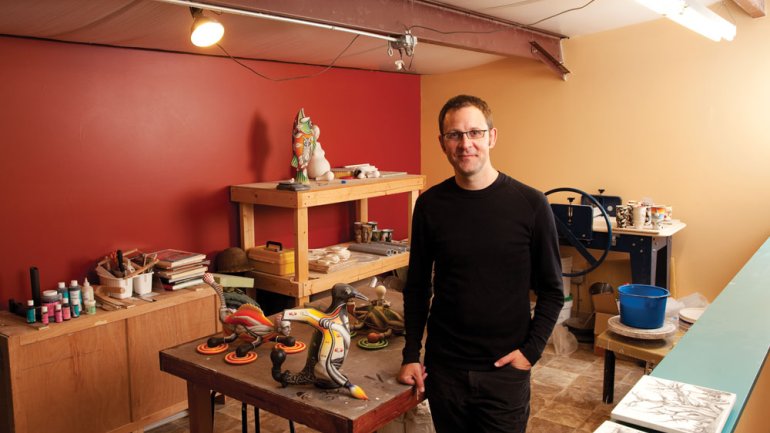The Nature of Invention
The Nature of Invention
Through his painted porcelain sculptures, Jason Walker asks us to ponder technology, wilderness, and our place in the world.
When Jason Walker was 21, he and a friend biked from Vancouver, Canada, down through Washington and Oregon, then turned left to end up in his hometown of Pocatello, Idaho. The tour took 30 days, covered some 2,000 miles – and gave him a new outlook on life.
“It completely changed the way I thought about distance, time, and space,” says Walker, 39, now living in Bellingham, Washington. Ever since, he’s been fascinated with how our inventions – from the bicycle to the computer chip – alter our perception of nature.
Walker mines this rich vein in his porcelain sculptures, exquisitely formed and painted narratives in which bears, rabbits, squirrels, birds, and other living things coexist gamely, if a tad uneasily, with man-made devices – light bulbs, spark plugs, motorcycle parts, power lines. His works invite us to ponder timeless, and timely, questions: Is technology friend or foe? How did “wilderness” evolve in the popular imagination from a place of isolation and danger to one of solitude and solace? And if humans naturally innovate and progress, then what is “nature,” anyway?
“I don’t try to propose that I have the answers,” says Walker, who loves the outdoors but doesn’t hate technology. He wears glasses, has a cell phone, drives a car; his influences include the visionary media theorist Marshall McLuhan as well as the 19th-century naturalist John Muir. “I just try to present ideas and look at things with a critical eye.”
Each of his pieces is a tour de force of three-dimensional form combined with two-dimensional imagery. They begin as clay slabs that Walker forms by hand, adding thrown and cast parts as needed. He then paints intensely detailed scenes over the entire piece; each takes him about a month to complete.
For years he used commercial underglazes, but lately he has been experimenting with china paints for more vivid colors. Haunting, sometimes dark, but lightened with touches of wit and levity, the finished sculptures explore themes such as Manifest Destiny, energy and the environment, and “the dichotomy between nature and culture.”
Much of Walker’s inspiration has come from what he calls his “image collection research excursions.” Alone with his backpack and sketchbook, he has hiked 100 miles through Yosemite National Park and wandered the canyons of the Grand Staircase-Escalante National Monument in southern Utah.
“I kind of borrowed the idea from the early American painters, like the Hudson River School – Thomas Cole, [Albert] Bierstadt, [Thomas] Moran, those guys,” he says. “Back then, that’s what they had to do – hike out onto a hillside, make sketches, get to know the landscape, then go back to the studio and paint.”
He’s also made urban expeditions to Seattle and Chicago, to scout out “the landscape of technology.” And now that he and his wife (an economic consultant specializing in natural resources) have two daughters, he also finds ideas closer to home: Little girls figure prominently in Gifts for the Kids, a series of pieces about climate change.
Throughout his own childhood, Walker drew constantly and in his teens had a job painting billboards after school. (“It was awesome. That’s where I really learned how to use a brush well.”) As an art major at Utah State University, he discovered the expressive potential of combining drawing and painting with clay. After earning his MFA from Penn State, he moved to Napa, California, and worked as a lab technician and part-time instructor at a community college. Then, camping at Lake Tahoe, he had an epiphany: He pictured himself earning a living as an artist, and resolved to make a go of it.
Back in civilization, he phased out his day job, began making bowls and cups, and had modest success selling them at craft fairs. Encouraged, in 2002 he got a two-year residency at the Archie Bray Foundation for the Ceramic Arts in Helena, Montana. “That was a major turning point. At the Bray, it all came together.” He has managed to survive and thrive as a full-time artist ever since.
“Jason has been uncompromising,” says Leslie Ferrin, who has represented him at her gallery in Pittsfield, Massachusetts, for the past decade. “He’s worked hard and been dedicated in pushing his ideas forward technically, as well as taking copious amounts of time to create these detailed narratives.
“He hasn’t rested on commercial success. If anything, he’s challenged himself to develop more involved forms, more intense painting. And the collectors have followed with him.”
Ted Rowland, a publisher of books on ceramic art, owns a number of Walker’s pieces. “Too often artists who attempt to make political or social statements do it in such a ham-fisted manner that the work is off-putting,” he observes. “Jason has this combination of form, imagery, and technique that remains true to his message while drawing the viewer to his point of view. He’s inventive without sacrificing his integrity.”
For the past two years, Walker has focused on experimentation and travel, and has done artist residencies in France, China, and Hungary. His latest direction is using those colorful china paints on large porcelain tiles (roughly 40 by 22 inches), which he then embellishes with clay elements to form a kind of interactive frame. Painting on a flat surface has taken him out of his comfort zone, Walker says, but in a good way: “It’s a totally brand-new challenge.”
Like Lewis and Clark, those other Pacific Northwest adventurers, Walker is on a journey of discovery, seeing the world from a unique and ever-changing perspective – and taking notes. In his visions, we may find something of ourselves.
Joyce Lovelace is American Craft’s contributing editor.




